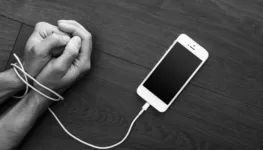It’s no longer a new or surprising topic of conversation: The whole world is way too addicted to social media sites and high tech devices like smartphones. The media continues to cover this story, but some of the urgency and even fear seem to have leaked away. After all, the consensus seems to be, it’s not like smoking or gambling — really destructive and foolish. It’s a foible, a mere idiosyncrasy, that most of the world can’t seem to get along without an immediate internet connection and their mobile device(s).
But studies, research and anecdotal evidence continue to show that growing dependence on modern communication technology is creating an unhealthy social paradigm. Just recently the LDS Church, with over 16 million members, disabled access to all social media sites in their chapels worldwide. Members and visitors can no longer check their email or Facebook page if the Sunday School lesson seems a bit boring. Teachers from grade school to college struggle to hold their student’s attention in class — in some cases banning smartphones from the classroom altogether. At business meetings the scourge of the disengaged attendees, who would rather text a friend or family member during a presentation, is creating a draconian mindset with managers and supervisors — they, too, are banning mobile devices during important meetings, to insure that staff pay attention to them, and not to their Instagram account. And programs that monitor social media activity at work stations is now standard at nearly every large and middle size business. Employees know better than to let the boss catch them tweeting at work.
Still, it’s just a smartphone,right? Convenient and helpful and efficient. So what if more people have cell phones than toilets worldwide? Calling it an addiction seems an exaggeration, a clickbait gambit to get people to read yet another article on the subject.
But no matter how it’s labeled, dependence on smartphones and other new technologies is a reality that makes more and more people uncomfortable — and opening up new opportunities for entrepreneurs to address the issue with workshops, addiction treatment and classes. Going off the grid, for even an hour, might seem easy to do — but the question remains; who’s doing it?
Those who want to limit their time and engagement to social media and other cyber distractions can now attend classes in just about every urban location that specifically address their concerns. Usually by using the Buddhist concept of mindfulness. To live in the moment and interact personally, not through a mobile device.
These classes use standard yoga and zen concepts to wean students from their dependence on smartphones. A group will meet, deposit their cell phones in a box that the teacher hands around, and then work on breathing exercises and yoga postures to take them away from a Pavlovian response to their ringtones and introduce them to the peace of mind and concentration that seems to be going extinct in this mad, rushing world.
Does it work?
Most class participants confess to an initial nervousness, something like mild withdrawal symptoms, when they are first parted from their smartphones — even for just an hour. But then the consensus is that once students realize their world will not crumble to bits if they don’t respond immediately to a text about where to eat lunch, going off the grid at regular intervals, maybe for a whole weekend, becomes both doable and enjoyable.








